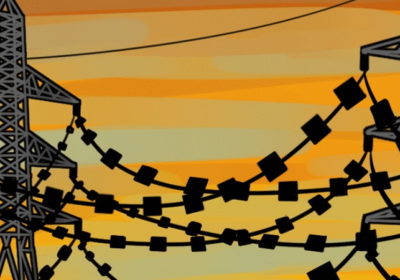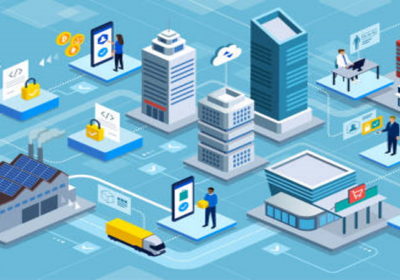
Blockchain is a technology associated with the concept of ledger accounting that enables the coordination of information between multiple stakeholders, in an environment where trust between them is not guaranteed. Its use in multiple areas of industry, economics and social development provides benefits that can result in reducing costs and minimizing the complexity of doing things in our current socio-economic systems.
Now, what are its most important characteristics, and why is its use growing so much in fields as disparate as digital governance or supply chain management? Let’s explore the properties that make up a blockchain system and take a look at the reasons that have led this disruptive technological solution to become part of the change that is manifesting itself in the management of our cities and, in general, of our society.
DLT systems
Blockchains belong to a broader family of technologies called “distributed ledger technologies” (or DLTs). In general, many of us use the terms “blockchain” and “DLT” interchangeably, although blockchain is a subclass of the latter. Thus, DLTs are a data storage system that differ from traditional centralized databases and distributed databases in one key respect: they allow multiple stakeholders to read and write data so that the information is chronologically ordered and immutable.
This is especially useful in a professional, industrial or economic environment where there is no mutual trust between members working together in that environment or where there is no (or no desired) common trusted central authority to coordinate or record information. Since the way data is validated in a blockchain does not require such a centralized authority, it can be implemented to facilitate transactions between multiple actors or parties who do not know each other, but do know how the technology works and how to work with it.
A new way of structuring recorded data
In order to address and solve the problem of lack of trust between the parties involved, the data structure is different between blockchains and the usual centralized databases, because if there is no central point of coordination, then the whole process must be managed differently to still ensure that everything works as desired.
The databases that, generally we have used so far in all services and systems that require information storage, tend to store it in table form, where information can be created, read, updated and deleted. A blockchain stores information in blocks of records (transactions) that are only added sequentially, and each of these blocks is cryptographically linked to the others. Therefore, transactions or information can only be added to the blockchain records sequentially (so that existing records can only be updated by adding new records and not by updating previous records). These blocks are periodically added to the blockchain network through a consensus mechanism that depends on the type of blockchain we are using.
Thanks to the above, DLT systems have several key properties that make them ideal for coordinating information and not relying on trust or prior relationship between businesses, companies, individuals or governments to exchange that data, creating a single version of the correct information for all among all users. The main properties that make blockchain such an attractive technology for these purposes are immutability, transparency, security, consensus and smart contracts.
Let’s look at them one by one.
Transparency, all data is visible to all network participants.
Blockchains provide full visibility to the users of a DLT system with a single version of the “correct information” being shared in a peer-to-peer network, i.e. all users of the blockchain have the same kind of right and access to read all the data stored in the blocks, and these are fully transparent to any user.
This transparency can be controlled by various levels of permission to read the information, something that does not exist in many of the conventional data exchange networks, where it is not possible to obtain, in many cases, full access to the information stored in centralized databases that depend on third parties, and where only some users with permitted access from that central authority can interact with such information.
Immutability, data cannot be changed
When information is recorded on the blockchain, it cannot be changed or deleted without it being clearly visible that there has been any alteration to other users/nodes in the network. In fact, in reality it is that nothing can be altered that is already previously recorded without a complicated alteration of all previous nodes and all transactions already approved and concatenated. In this way, the records of the transactions/activities that are written in the blocks are time-stamped and cryptographically linked to each other by complex mathematical algorithms which makes it easy to detect any tampering with the information in any previous block and makes it really costly, in terms of time and computational resources, attempts to alter or hack the system. That is why this property of immutability is what allows blockchain technology to be used in applications that need to reduce fraud and data falsification, problems often faced by many companies that have to deal with data of thousands or millions of customers and users.
Security, increased protection against cyber-attacks
DLTs, by design and architecture, provide highly secure information recording and storage systems that are extremely difficult to hack. Through the use of digital signatures, for example, participants and nodes in a network can record their interactions with the blockchain and identify who has done what. The nature of the blockchain, as everything is replicated and shared among all the nodes and users of the network, means that, in order to modify the stored information, hackers and hackers must change the information in each of the network’s copies, something we have already mentioned is extremely difficult and involves so many resources that the mere attempt to do so becomes unfeasible.
Therefore, security, privacy and compliance with the legal regulations that exist in each jurisdiction or industry are reinforced with the use of DLT technologies due to the high degree of integrity, availability and auditability of blockchain transactions. And the fact is that, as we already know, nowadays information security is of critical importance for governments, companies and individuals: just think of the systems that have been hacked over the years and whose data has been stolen from centralized databases guarded by a single authority. The use of DLT technologies offers us a solution to improve this aspect by storing information in a distributed way, which makes it more resistant to the usual cyber-attacks.
Consensus, how to reach an agreement to guarantee the veracity of the data
As a natural part of the functioning of a blockchain, all participants and nodes that are part of the network must agree on what is the correct version of the information they store, without relying on a centralized authority to do so. Thus, the technology underpinning blockchains uses consensus algorithms to facilitate this. In the case of the Bitcoin blockchain, for example, a proof-of-work (PoW) algorithm is used, but there are many different consensus algorithms, such as the Proof of Stake used by other blockchains to minimize the energy consumption required by network management algorithms.
Basically, a consensus mechanism is a way to coordinate participation in a network through the application of a voting system that stakeholders agree upon. It is much more effective and faster to decide through an automated consensus mechanism to record data on a blockchain than to have to chase different parties by email to authorize and confirm a transaction when it depends on a central authority to manage the transaction.
Smart contracts, automatic execution of processes

Finally, smart contracts are computer programs that automatically execute instructions when pre-set events are triggered in their code to do so (e.g., delivery of goods to a person leading to a payment by the customer in an automated way). We can think of them as a business logic that is embedded in a transaction log, programmed directly on the blockchain, and that no one, as such, controls, as they work simply by a series of rules that are executed when the conditions programmed for them are being met. Thus, smart contracts can be used to automate business processes in different entities and, unlike conventional computer programs, the rules of the blockchain system guarantee the execution of a smart contract when it is activated. They basically work on the logic of “if this is fulfilled, then execute this”. In addition, the result of an executed smart contract can also be audited and verified by all participants in the network.
This innovation, which was born with the Ethereum blockchain and has been improved and developed since then in successive versions, aims to drive innovation in business processes with automation, speed and compliance with what has been agreed between the parties without great costs and risks for those involved, preventing situations of distrust in which, for example, we do not know if we will receive our order after having made a payment if this payment depends on the willingness or good faith of one party to do or not to do so. Smart contracts can also be used to create tokens, which are giving rise to new business models transforming the global economy, something we have already been seeing for years in the financial system of our society. In general, just think of the amount of time and costs wasted in processing basic legal contracts, which could be largely automated if there were clear agreements between the parties involved that could work automatically.
In summary
It should be noted that all of these properties we have described in a general way are based on decentralization, and this is itself a fundamental property in general of blockchain-based systems. Decentralization is not only about no longer requiring a centralized authority to control and verify information, but also about disintermediation. This refers to stakeholders who may no longer be needed in many business processes that tend to increase cost, time and complexity. There is still much to explore with this technology and there are many applications to bring to the market that will provide us with solutions that we cannot even dream of for problems that, now, seem difficult to solve.



